
Rockin’ in the Free World
It’s been a big year for outdoor festivals, complete with big crowds, big stages and, yessiree, big PAs, so here’s a suitably big article.
Text: Chris Braun, Dave Richardson, Christopher Holder, Andy Stewart & Mark Davie.
CHRIS BRAUN – FOH
This year I’ll be taking you to the Falls Festival in two states, Southbound in WA and Sunset Sounds in Brisbane with Melbourne band Blue King Brown, USA’s Eli ‘Paperboy Reed’ & The True Loves as well as TZU.
For those who don’t know Eli ‘Paperboy’ Reed & The True Loves, they’re a US band out for their first Australian tour. I was offered the mixing gig. After a quick snoop around their MySpace page the seriously cool, rhythm & blues-meets-funk style had me instantly hooked. I couldn’t wait to mix these guys. Anyway, let’s get straight into the tour.
FALLS MARION BAY
Johnston Audio Services take care of the Falls production. It’s always nice doing shows with these guys. I’ve spent that much time emailing and talking to Johnston’s Paul Gould, I think he knows the Blue King Brown setup better than I do by now, almost to the point where he probably senses a ‘disturbance in the Force’ when another input or monitor mix is added to the spec!
After arriving at any festival a few things happen straight away. Dave Richardson (our monitor engineer) and I head straight for the stage to see who’s running things. We’ll organise a quick production meeting to get any questions the crew may have out of the way; to make sure the correct production rider has been sent through and that everything we need is on site and good to go. Once we know the infrastructure is in place we can have a little rest before setting up monitors and miking the gear.
First stop is Falls Marion Bay with Blue King Brown and Eli ‘Paperboy Reed’. Waiting for us in Marion Bay was a full EV affair with an EV X-Line for FOH and X-Array 15-inch wedges, a Midas XL200 (in possibly the best condition I’ve ever seen) took care of FOH duties, while we had a Yamaha PM5D on stage for monitors. The FOH rack was very nice – a collection of dbx, BSS and Avalon compressors, Drawmer gates and the usual suspects for effects. Collin Ellis (INXS, John Buttler Trio) had the system absolutely singing, which made it a pleasure to mix on.
Mixing Blue King Brown and Eli ‘Paperboy Reed’ & The True Loves could hardly have been more different. It was good to step out of my comfort zone with the Eli mix and try some new stuff. I got a very specific brief for how they were to sound out front so I had something to work towards: a nice round bottom end that hit you without being too subby, a snare sound that people should feel in their chest, a nice sharp horn sound and take it easy on the reverbs. So, like I said, it was a little different to the body-hugging, ankle-shaking bottom end I give Blue King Brown.
Next up, at Marion Bay I had Blue King Brown, which always proves to be a festival favourite and the crowd swelled as we line-checked. I don’t like checking the band through the PA anymore; I like to have the first hit of the band come as a surprise to the audience – swinging from quiet ‘hold’ music with a bit of the bottom end rolled out, to 100dB-plus of good times. So it’s a case of pulling the sound in my headphones and then I’ll put just a tiny bit of kick, snare, bass and lead vocal through the PA to make sure my headphones are translating to the PA.
The PA in Marion Bay sang! I haven’t had too many great EV experiences, so it was a pleasure pulling a mix together on the X-Line and, given the array’s size, I was quite surprised at how much it could handle – it soaked up almost anything I gave it. I did come up against some issues with the high end not handling some of the transients coming from percussion but the top end still sounded great anyway.
FALLS LORNE
Next stop was Falls Lorne. Falls Lorne is the big brother to Marion Bay, and ‘big’ is the operative word. This was going to be my first time mixing the Falls main stage and I couldn’t wait. I felt like a kid in a candy store – the production rider here is just about my ideal setup. A Midas H3000 with a selection of dbx, BSS and Drawmer outboard as well as a lazy selection of dbx valve compressors, which I used for vocal and bass duties, all driving the Nexo Geo-T line array… what more could you ask for?
On stage, it wasn’t much different, more Nexo PS15s than I’ve ever seen in one place at any one time, two Yamaha PM5Ds, more rolling risers than there were people (and ample space for setting up), a stage crew with their heads screwed on and smiles all round… this was going to be good fun!
After a quick production meeting, the plan was set and the stress levels were dropping. Before too long it was time to set up Eli ‘Paperboy Reed’ & The True Loves and make the journey through the crowd to FOH for some fun. Brent Gray (Silverchair, Missy Higgins) was system tech for the Falls rig and had the Geo-T rig really performing – there was more than enough headroom in the PA, which meant some good times ahead.
Right after I finished Eli’s mix it was back to the rolling risers to set up Blue King Brown. We put drums, percussion, keys with lead guitar and the horns all on rolling risers these days and it makes things very easy. We’re now touring a full mic and DI package as well, which means we don’t have to rely on the production company having two stands and mic packages on the show.
The Lorne Falls Festival show was incredible. The 20,000-strong crowd in front of the stage filled my veins with adrenalin – then the word came, it was game time. Hitting play on the intro track sent sirens blaring, the crowd jumped to their feet, roared, then hoisted blow-up rowboats into the air as its occupants ‘rowed’ their way across the crowd until boom! Pete’s drums dropped like an atomic shockwave.
Everything on the Lorne show just worked: the band, the stage crew, the crowd, the PA… it just all came together to create one of the most memorable gigs I’ve ever mixed. It was also one of the easiest gigs of the run, so a massive ‘thank you’ must go out to Johnston Audio and the stage crew who looked after us so well.
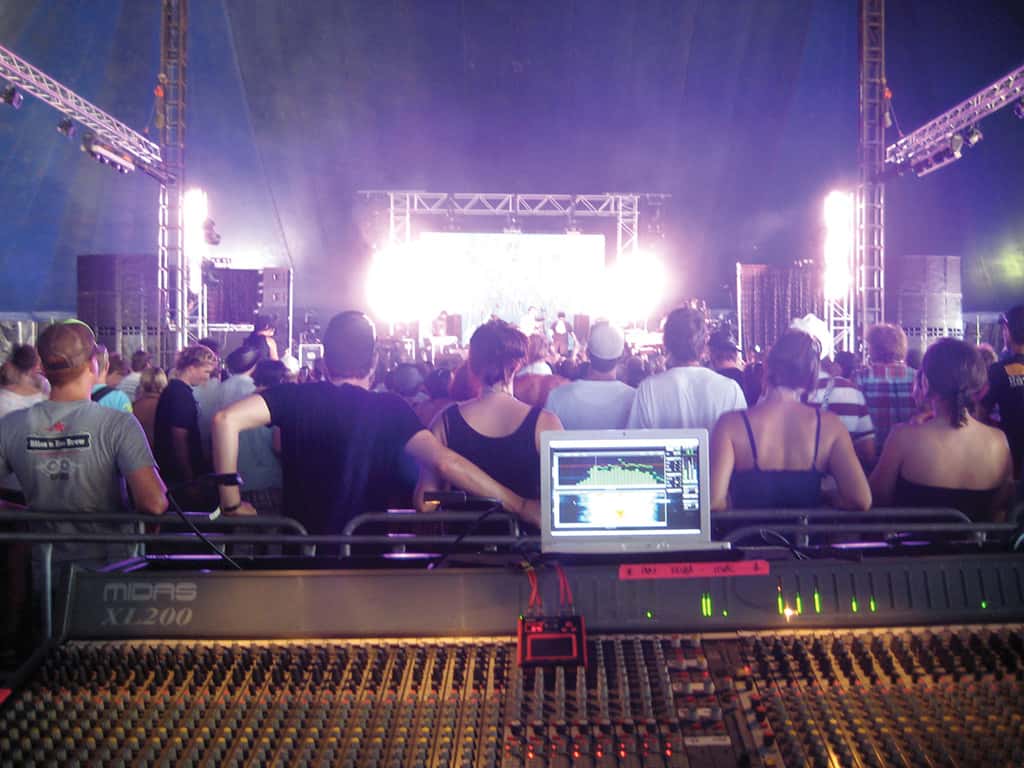
GO WEST
Next, it was time for another flight, this time to WA for the Southbound festival… at 6am! After another three hours sleep I woke up 45 minutes after my alarm… crap! “Guys, I’m on my way, I’m in the cab now… it’s all good!”
Southbound is three hours south of Perth, in Bussleton to be precise. I’d been brought onto this show fairly late in the piece and hadn’t made contact with the production company – it’d be a case of making it work on arrival. Fortunately, AAA Productions were looking after the stage and they’re a solid crew, so I wasn’t concerned.
I was with the band TZU, which was playing the Big Top. The tent must have held 8000 people or more – it was huge. Out front was a Midas XL200 with dbx, BSS and Drawmer inserts and Lexicon, Yamaha and TC Electronic effects. The FOH PA was an EV X-Array and there was plenty of it! I was a little nervous when I did my walk around the venue during the previous band’s performance – the coverage didn’t seem all that great and the subs weren’t really moving the sort of air I knew I would be looking for during the TZU show. I need the sub support because Corey (aka ‘Yerock’) drops some seriously low tones (somewhere in the vicinity of 50Hz). Not only do they drop some tones but the samples and drumbeats themselves have some serious sub information as well. Thankfully, when it came time to hit the ‘Go’ button, all was fine. The PA opened up and had more than enough power for me to actually pull the subs back in certain areas, leaving me the extra headroom to respond to the times when the sound really needs some low-end push.
On this show they were adding a live band to the existing line up, which brought a smile to my face because it meant I had a live drum kit to play with, giving me more control over how I wanted the drum sound to be heard and felt. I’m often limited to the drums coming down a pair of channels from an Akai MPC – which I still had – but having the additional live kit meant I was able to really get the beats cranking.
The guys kicked off without the drums and when the drummer came on, he was playing along with the MPC beats but I couldn’t hear anything… What the hell was going on? Everything’s switched on; I was just hearing them in the line check… what had changed? Straight onto the comms to monitors:
“Are you getting drums?”
“No, we’re not. Should we be?”
“What do you mean ‘should we be?’. He’s playing the bloody drum kit!”
Then, suddenly, boom! the drums dropped. Up to that point he’d only been playing ‘air drums’, getting into the rhythm of the MPC.
Back to DefCom3 people – stand down.
Southbound was hot… damn hot. I was knocked around by the heat quite badly on the second day, I’m talking blurred vision, trouble walking etc. So by the time Blue King Brown arrived on site I felt like death was a viable alternative. I’d just drank four bottles of water with no discernible effect and no trip to the bathroom. One of the crew from Phase One Audio Productions saw I was in trouble and gave me a green drink he was feeding his crew. It wasn’t the greatest tasting thing in the world but after about 20 minutes of sipping this stuff I started feeling better, and within an hour I was back to work. So, thanks to Phase One Audio, which incidentally organised a very tidy stage.
Soon it was time for Blue King Brown to take the stage and this is where the Geo-D would be tested – and it acquitted itself well. The system tech had the rig singing and it was nice and easy to get going. Southbound had a 100dBA noise restriction for each stage, which is always annoying but it didn’t get in the way too much. The PA delivered a sound that was clean and clear, the crowd ate it up – everyone was happy.
Nat [Blue King Brown’s singer] took one of her walks around the crowd barrier into the crowd which meant walking past the front fills. Squeal! Other than that, it was a cracker of a show.
Personally I couldn’t wait to head back east – the heat was starting to take its toll. Just before landing in Melbourne the hostess conveyed the good news – Melbourne was going to be 17 degrees on arrival. Yes!
SUNSET SOUNDS – SUNSET CLAUSE
The final show of the tour was at Sunset Sounds in Brisbane. We were lucky enough to have a couple of days at home to recharge the batteries between Perth and Brisbane. So far it’s been eight mixes, five days, three states with three different bands and no sleep… ah, the delights of touring.
Sunset Sounds is a new festival based at the Brisbane River Stage and surrounding parks. Like any new festival, it had a few teething problems but the crowds were great and Johnston Audio had the rig working beautifully. There was a Yamaha PM5D on stage, while out front was a big Nexo Alpha PA driven by an old-school Soundcraft Series 5.
Unfortunately, Sunset Sounds was let down by the noise restrictions which were the heaviest I have had to deal with anywhere – 95dB C-weighting! Bloody ridiculous! The sound of the faders moving on the console is louder than 95dBC!
Come showtime I was straight out of the blocks with 103dB and got the tap on the shoulder – “turn it down”. There’s no point in fighting with the EPA guys – you just won’t win. You’re better off co-operating to ensure you both get what you’re looking for, and, most of the time, if you’re pleasant you can squeeze a couple of extra dB out of them by the end of the mix.
But the heavy restrictions have a serious impact on the audience – there wasn’t enough weight behind the mix to involve the crowd. I was happy with the way the mix sounded, all it needed was another three or four dB and it would have pushed it over the line.
With Sunset Sounds done and dusted it marked the end of the New Years festival run and it was time to head home. It was already the 9th of Jan. Don’t ask me what day of the week it was… I was still operating on dates alone.
It’s been a flat out start to the year with more mixes than there have been days in the week. The crowds have been big and the sleep scarce. But there’s plenty of satisfaction to be had. In fact, mixing festivals is great fun… when everything works!




THE BIG DAY OUT
John Ashton, FOH Engineer for Arctic Monkeys
Main Challenge: The Arctic Monkeys set up so close to each other and play at such volume you get a lot of spill into the wrong mic, particularly Alex and Matt’s vocal mics picking up the drum kit. I’ve tried many different mics but I’ve yet to find the right one or any satisfactory solution.
Guitar Amps: I use a Shure SM57 on the front of Al’s Selmer amp, and a Sennheiser MD421 on the back. I do the same for Jamie’s Bad Cat, and for his Hi Watt I use a Sennheiser e606 on the front with another 421 on the back. Having mics placed back and front stems from the early days when they used single coil-loaded guitars through tinny little amps: I used the front one to capture the detail – the ‘in your face’ element – and the back to try and get some meat into the sound. As they bought better equipment and we had a bit more room on stage, it became noticeable how much beefier the sound coming out of the back of the open-backed combos was, so we kept sticking mics there. It also gives me more flexibility – the amps sit in the mix in a much nicer way because I can work on a more specific, more controllable range of the audio without compromising the elements that aren’t sticking out like a sore thumb… if that makes sense.
Ableton Live: I use Ableton to trigger some very low-frequency booms at certain points during the set, to give the crowd a bit of a tickle. I love Ableton, it’s so handy to have around. If the band wants something recorded, say, during soundcheck, it’s just a case of ‘plug and go’ and I can have it on an iPod within five minutes of them getting off stage.
Plug-ins: I use a basic collection of Digidesign Profile plug-ins: D-verbs, a tap delay, a slap delay, a vocal distortion using Amp Farm, and the Smack! compressors on the bass, Al’s vocals and kick, snare and guitar groups. The band makes such a glorious racket there’s no point fannying around with it if it sounds good flat.
Vocal Chain: Al’s vocal signal path is a Sennheiser e945, into the desk, the Smack! comp, a bit of onboard EQ, then I shove it back out through the ‘big stereo’. Easy.
Digital Desks: To be honest, I reckon I’m going off digital desks and the world of plug-ins. With so much arsing about with the possibilities it’s easy to forget what you’re actually trying to achieve. You’re not Phil Spector’s successor and no-one gives a s**t that you’re using plug-ins modelled on John Lennon’s very own arse if they can’t hear the words of the songs by the band that they’ve paid good money to see.
BIG DAY OUT FOH SYSTEM
JPS Operations Manager, Brad Kerns: All fairly straightforward this year. The new Crown amps are working out well. Digidesign Profiles at FOH and Yamaha PM5Ds for monitors – no raised eyebrows by any engineers when they saw those on the rider. We used L-Acoustics ARCS and dV Subs for sidefill on one stage while Neil Young’s stage had Clair R4s as monitors along with d&b Q Series speakers hung high as ‘sidefill’. I wouldn’t say it was a ‘walk in the park’ – the heat wasn’t easy – but there weren’t any major dramas.
54 x JBL Vertec VT4889
24 x Vertec Amp Rack (MA5002)
48 x Crown MA5002VZ
68 x JPS sub bass (JBL 18-inch)
8 x Meyer MSL-2A loudspeakers
1 x Vertec Drive Rack FH6 (Dolby)
3 x Dolby Lake DLP4D12 Processor
2 x BSS FDS-366 Omnidrive
System Engineer: John ‘JK’ Kerns
JPS Crew: Cameron Elias, Tristian Johnson, Simon Farrell, Duncan Kaye, Josh Jamgotchian, Adam Williams, Joel Whyman


Arctic Circle: The Big Day Out rocked to the sounds of the Arctic Monkeys. Digidesign Profiles populated the FOH position while the band’s FOH Engineer, John Ashton, keeps his Ableton Live close.

NEVEREVERLAND
Since bringing out Nirvana at the height of grunge, Steve Pavlovic, the fledgling-music-promoter turned industry-taste-maker, has grown his Modular label roster into a balance of some of Australia’s greatest hopes alongside impossibly cool international trendsetters. Now 10 years on from its inception, and with Modular artists topping the bills of most major festivals, it was high time Pav got back into music promotion. The Nevereverland festival gathered the cream of Modular’s crop and shoved them in various capital city arenas, including Melbourne’s own Sidney Myer Music Bowl.
AudioTechnology was at the Bowl for the day, soaking up the mix of Aussie and international acts, including the Presets, Klaxons and Cut Copy. Adrian Donadei was first engineer off the ranks, usually seen at FOH for Cog and Butterfly Effect. He was mixing Van She for the first time and looking forward to the fresh perspective. Later, we caught up with John Hall, who was back on the road with Cut Copy. After a close call up in Sydney the day before, courtesy of some awkward patching, all eyes were on Hall to come up with the goods. It seemed the pressure paid off, even the Klaxons engineer spent a good part of the set listening in, enthusing how ‘it sounded massive’, while the Bowl’s environmental audio consultant, Andrew Rodgers, reckoned he still had 3 – 4dB in it.
Jands Production Services provided the system for the day, which had come fresh from MGMT’s Melbourne show. It consisted of a Digidesign Profile at FOH, with 12 x V-DOSC, 8 x ARCS, and 16 x SB218 subs as the main PA hang. For such a large show, where more than half the crowd ends up on the grassy incline behind the sound tent, there was a suspicious lack of delay speakers. Pat Richardson, system tech for JPS, explained why:
Pat Richardson: Apparently there are people in a building behind us who hate all sorts of music.
Mark Davie: I saw one of your compatriots running around with a SPL meter outside, whereabouts do you take the readings?
PR: The residences nearby are the first to complain so that’s the first place we do checks. I think the rules are 65dB A-weighted over there. But we were just running 100dBA at the console and only 60dBA over there – we’ve got the wind in our favour [blowing back towards the bowl]. The environmental side of things is really important at this venue. I was in here with the Red Hot Chili Peppers, and we had no end of problems. We did tests over subsequent days and found we could run an inside system quite hard and not have any problems environmentally, but as soon as I turned the outside system on [delay stacks] it was a nightmare.
MD: So no delay stacks?
PR: No, I just haven’t installed any. You can cover the whole venue from the shell, but my brief was not to cover the entire venue. What I’ve done is put in quite a large front fill that will cover halfway up the hill. I’ve also turned the system in, so it doesn’t reflect off the sides of the sails [roof]. You can get quite hard reflections that will go for hundreds of metres in the high end.
MD: Is this one of the worst places to mix?
PR: No, it’s a lovely sounding place. I’ve had fantastic shows in here. I did a show with Midnight Oil in here many, many years ago, and Colin Ellis was mixing it. It was [Clair Bros] S4s in those days. And it was one of the most amazing shows I’d ever heard in my life. But in those days, we didn’t have the same noise concerns.
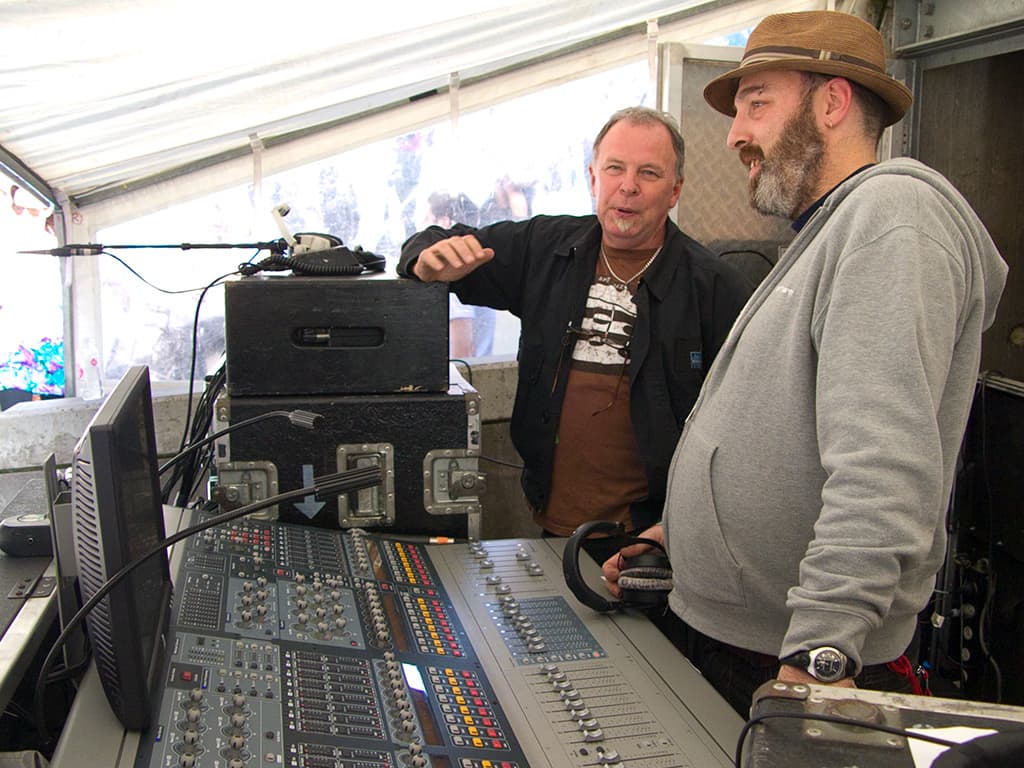
BIT OF BOWL HISTORY
Richardson has a point. In the ’70s, over 200,000 people rocked up to hear Billy Thorpe and the Aztecs at the Bowl. Most of the crowd stretched out into the trees of King’s Domain, and couldn’t see a thing, but the design of the Bowl carried the sound for several kilometres. And herein lies the problem. The bowl was originally commissioned by the Myer Foundation to hold Melbourne philanthropist, Sidney Myer’s, free Melbourne Symphony Orchestra concerts after his death. At the cusp of its 50th anniversary, the natural projection characteristics of the horn-shaped bowl, inspired by Louis Armstrong’s trumpet (true story), is now causing havoc for amplified rock bands trying to keep the noise down. The times they are a changin’, and the venue hasn’t changed with it. Saying that, you’d like to reach out and throttle a handful of noisy killjoys in their St. Kilda Road apartments.
Actually, speaking of giving mouthy cretins a good slap, a certain Nevereverland punter came to mind.
It was just before Cut Copy’s set. A spiky-haired, orange t-shirt wearing, shifty-eyed Modular punter – let’s call him Numbnuts – charges up to John Hall and Pat Richardson specifically to tell them how rubbish they are, that he’s been to a lot of parties, and it’s never sounded as bad as this. After more than a few minutes of trying to communicate through the early evening stupor of this ranting sap that the distortion wasn’t at front of house, but coming off the DJ’s mixer, Numbnuts finally comes around. “Well, you should tell him he’s s*** then”… Thanks Numbnuts. “I don’t tell the artist what to do,” explains Pat. “I’ll tell you what,” he says, reaching into his breast pocket and pulling out a backstage pass, “why don’t you go tell him.” Right about now, the tables have turned, and Numbnuts looks right scared. But the opportunity must be seized. For once, his high horsemanship has served its purpose, here’s a chance to complain to the right person; to take his concerns right to the source… to finally make a difference. He diffidently takes the pass and asks a few more times exactly what Pat means before edging cautiously to the stage. At the bottom of the stairs Numbnuts hesitates, he can’t decide if what he’s about to do is heroic or idiotic, and a long look at the bouncer makes him question whether he should get up, or if he’s been set up. He waits at the bottom of the stairs, and waits, and waits… till the DJ has finished, packs up and walks off. Then with all the conscience of a coward who thinks he deserves better, eagerly heads upstairs to party on with the privileged. Typical. Who cares… It’s just the sound right?
BOWL GIVEN THIRD DEGREE
Well, we care that a national landmark can’t be turned up above a horse’s whisper. So we turned it up and asked why.
When AT found out Doug Pringle from Johnston Audio Services had recently been blasting out 100dB of pink noise at the bowl, testing different speaker configurations to determine the worst noise polluters, we asked him how they went. His findings are yet to be fully analysed, but it seems he largely agrees with Richardson’s conclusions. “If you have a delay system running hard at the tip of the bowl, you’re going to run into problems, it depends on how hard you run it, and not so much where you run it. The other areas, such as the main hang, are not a problem. Most of the time you run into problems because the promoter has control over the production dictating how loud the show is and leaving the audio guys to deal with the mess later.”
As it turns out, the Sidney Myer Music Bowl is being put through the ringer. We talked to Glen Hirst, Manager of Sidney Myer Music Bowl Events, about the state of play at the Bowl. He told us that, at the moment, the outdoor venue is subject to a noise abatement notice from the EPA that limits them to – wait for it – the grand total of six concerts a year. A ‘concert’ is classified as an event that exceeds 55dBA, and is below 65dBA at the closest residence. With the Bowl projecting like a horn, and the residences so close to the mouth of the bowl, suffice it to say, almost everything is a concert. So, like Doug, they’ve been conducting tests to see what the best possible speaker configurations are, which is looking like it all comes down to how the delays are hung. All things considered, though, there’s no iron-clad prescription for legal sound and attaining ‘Concert’ status. The environment plays a big part. If a breeze is blowing away from the apartments everything is usually okay. And if it just so happens you have a favourable gale on your side – like the one we experienced on the day of Nevereverland – the apartment block SPL meter hardly troubles the scorers. The Bowl just scored itself a free ‘concert’ it would seem.
MEREDITH FESTIVAL
Weathering the storm of the economic climate change, or even weathering the storm of climate change can be merciless at times, especially for festival planners banking their financial year on being outdoors in Summer. But when December comes down upon the earth like a wet blanket, there’s not a lot you can do. Meredith Music Festival copped the full brunt – it was, in fact, the wettest 24 hours for quite some time. Luckily for Aunty Meredith and her band of organisers, 17 previous years of solid lineups and good vibes meant Meredith was one of the few to sell out well in advance of showtime. Total Events, formerly dB Concert Sound, supplied a vintage JBL modular system for the weekend, consisting of 24 x two-inch horns, 24 x 12-inch mids and 24 x 18-inch subs per side, with a centre cluster of 12 x dual 18-inch subs. The FOH console was a Midas Heritage 3000 and a Yamaha PM5D took on monitor duties, driving 10 active sends, comprised of JBL boxes and Australian Monitor/Crown amps. We talked to Paul Martin, stage manager for the weekend, about how he and the gear coped.
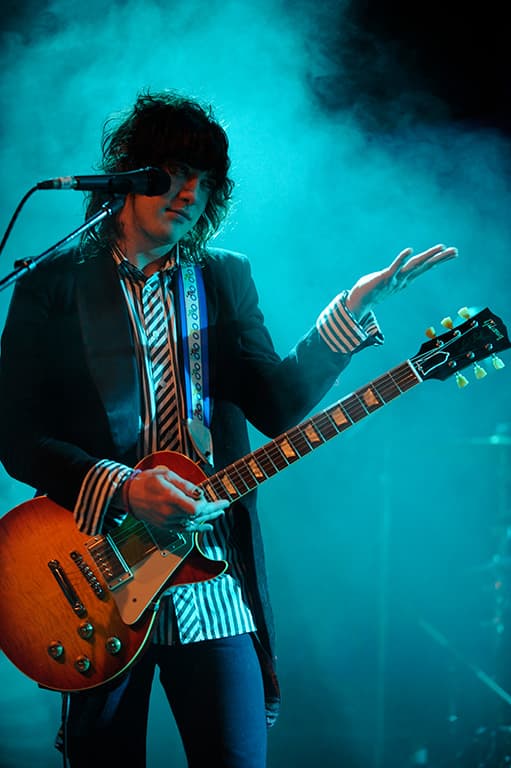

Paul Martin: Well, it wasn’t as bad as other years. A while ago, when The Dirty Three played, we had a thunderstorm come in as quick as you could say ‘look at that’. It moved in, dumped a good 20mm of rain and formed a creek that ran down through the amphitheatre and under the stage out to the natural creek. The site’s been set up to handle that, so nothing bad was going to happen. Another year it was 42 degrees, and you could smell the embers of bushfires that were only about 20km away. And then this Summer we had 50mm of rain over two days. The bonus was that it started raining before everyone got there.
Mark Davie: So how do you stop a wet blanket being thrown over the PA?
PM: The guys that run the festival, Matt High and Greg Peel, are very cluey fellas, so on site there’s a whole lot of infrastructure put in. It’s a big stage, about 15m by 12m, with a roof that extends about another 6m or 8m over the crowd as well, so if it does rain, a minimal amount of gear gets wet on stage. And because it’s an old PA, the speakers are set pretty far back into the box, so unless you get a hose and pour it directly into the front of the box they don’t really get wet.
MD: Did you pull on the gumboots?
PM: I work pretty hard, so I don’t leave the stage that often, and they lay down gravel everywhere I walk. I wouldn’t want to be a punter though, there’s people sliding down hills on esky tops! But the people that go to Meredith are regulars – they go every year; it’s a ritual thing. I know people go there and enjoy being dirty for a weekend. Now that we’ve got proper toilets and showers, they still just go there and let loose for a weekend.
PEATS RIDGE FESTIVAL
For Peats sake! While the great climate change rains all over one parade, another is trying to save the world from it. Peats Ridge Festival is the first major event in Australia to run completely on renewable energy, taking out the 2008 Green Globe gong for leadership in environmental sustainability across all industries in NSW. Running since 2004, the green festival was cancelled last year due to rain (oh, the dripping irony), but this year around 200 artists took to the stages for the New Year’s weekend, including the likes of Temper Trap, Blue Juice and Snob Scrilla. Norwest Productions provided 12 stages of audio, including the three main stages, all running off generators powered by bio diesel (chip oil, to you and me). All up, Norwest staff, led by Adrian Riddell, mixed over 150 bands and acts over three days. Peats Ridge is one of the more diverse festivals on the Summer calendar, with everything from rock to reggae, hip-hop, dance and funk. Systems ranged from EAW KF760 and EAW KF730 line array systems to dance tents using Funktion 1 Res5 and SB218 systems.
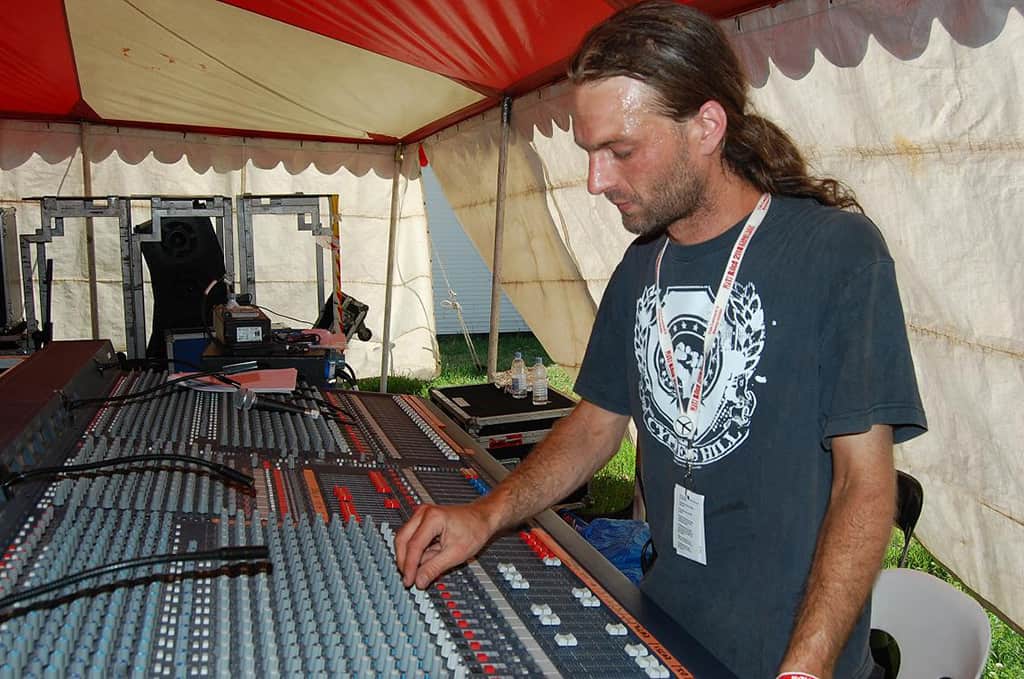
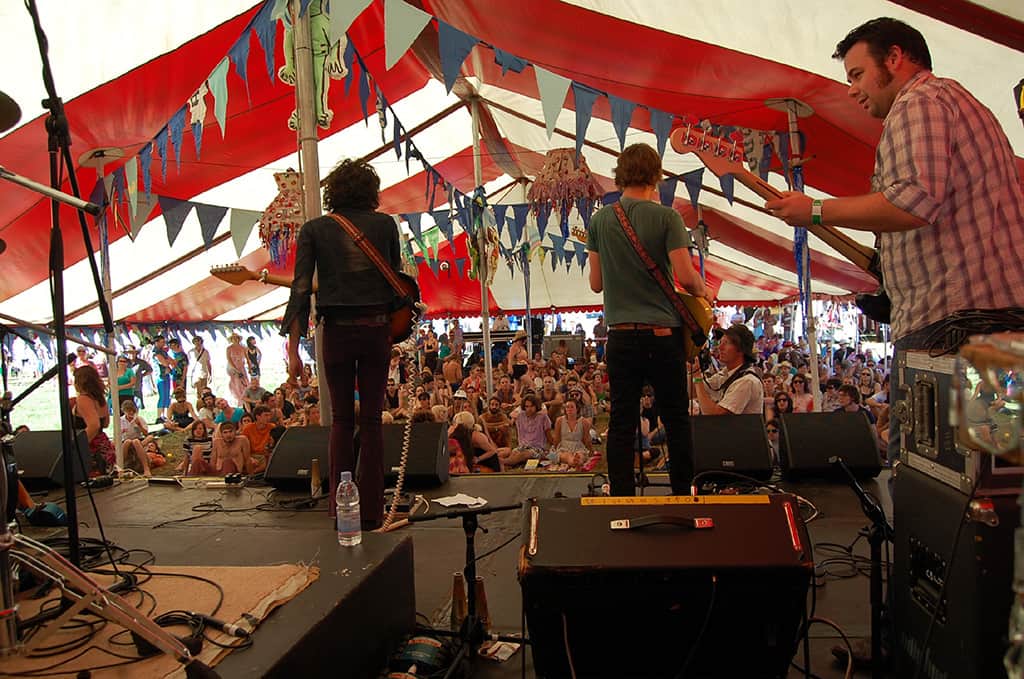
NEIL YOUNG AT THE SIDNEY MYER MUSIC BOWL
The stars twinkled particularly sweetly over the heads of 30,000 adoring fans at Neil Young’s Sidney Myer Music Bowl concert – no rain like at Meredith, that’s for sure, t’was as dry as a packet of Samboys. After a day of brain-addling heat that threatened to melt both the crew and the scaffolding, the fans turned on, the fans turned up and ‘old black’ (Neil’s fabled Les Paul) tore through the night like a bushfire.
It was the perfect Summer gig, forged (almost literally) from a rare combination of digital FOH technology (Digidesign Venue, Dolby Lake Processing, Lexicon 480L reverb and Metric Halo A/D converters for recording the night’s performance), a JBL Vertec line array, a magnificent collection of exquisite organs, pianos, vibes and keyboards, and one of the greatest electric guitars to ever grace these shores. The sound was powerful and the performance, truly exceptional. The free world rocked and rocked… and rocked, as Neil returned to the mic for chorus after yet another chorus of his iconic rock monsterpiece.
It was at this point that my mind suddenly recalled the conversation I’d witnessed earlier between long-time FOH engineer, Dave Lohr, and the EPA (I was the fly on the wall), where concerns were repeatedly raised about the SPL at the front doorstep of the Bowl’s nearest neighbour. At the time, Dave had convinced the EPA there was nothing to worry about, but not even he could have predicted how loud or how long Neil would eventually play this particular number. I’m sure the EPA was wishing it would just go off, but not like this!
Apart from the Wizzer (Neil’s floor switcher), a vast array of ancient Fender guitar amps and a small collection of truly legendary guitars, Neil Young’s personal setup included a Neumann KMS 140 cardioid condenser microphone for every vocal position he might potentially occupy on stage – Centre Vocal, Pedal Organ and Piano. As Dave Lohr, pointed out: “Neil has no set list so we really have no idea what he’s going to play next. We set up the mics and instruments for all possibilities, and then it’s up to Neil what goes on. So although we’ve got a digital console with us here – as you can see – there are no snapshot settings for individual songs or anything like that. In this respect we’re treating the console very much like an analogue board.”

Andy Stewart: Frankly, I’m amazed to see you’re using a digital console at all. It seems incongrouous with the stage setup. Did Neil take much convincing of this major shift at font of house?
Dave Lohr: He did. He was quite apprehensive about the whole idea at first and some early shows we used it on had certain problems that Neil was quick to blame on the digital board. That turned out not to be the case, however, and now Tim Mulligan [Neil’s other FOH engineer] and I are getting what we need out of it. It’s sounding fine.”
AS: How long have you and Tim been mixing Neil Young live, I understand it’s been a while?
DL: I’ve been mixing Neil for about 20 years now, but Tim’s been doing it for at least 35. I originally started out as Tim’s assistant actually, and over time I started making adjustments to the FOH sound during gigs because there was simply too much for Tim to do – things have certainly changed since the simple days of guitars, bass and drums. So he eventually said, ‘just go for it’. These days we mix together – he takes care of Neil’s FOH sound and I do all the other voices and instruments that come in around him. Neil’s the focus of the gig obviously and Tim’s only concern is what Neil’s up to; where he’s heading to on stage and to what mic.
AS: Can you tell me what Tim’s using on the vocal and guitar chains for Neil? You’re using plug-ins I assume?
DL: On the voice we’re using Waves C4 multi-band compressor/EQ plug-ins for each vocal mic on stage, but there’s nothing on the electric guitar channels, they’re just raw Neil. We have different EQ settings for the different vocal mic positions, given the nature of the songs he plays at each mic. The pedal organ vocal position, for instance, usually involves a very intimate and close on-the-mic performance, so we tend to roll a little more bottom end out of that guy. Neil’s vocal effects are coming from outboard gear: a combination of a Lexicon PCM42 delay which we feed directly into a 480L to generate a big early reflection. The delay doesn’t come out dry, it just pushes directly into the 480 to create a big space around the voice.
AS: What mics are you running on Neil’s Fender amp setups?
DL: We’re running Shure SM56 and Sennheiser MD409 dynamics, which are unfortunately no longer in production. They’re great mics. We’ve got them on all of Neil’s amps.

AS: And I see there’s no conventional foldback on stage, nor any sign of in-ear monitoring systems… what’s going on?
DL: Well, this is where Neil’s setup is quite unique. I don’t really know of anyone else who monitors the way Neil does. In essence, Neil ‘plays’ the PA like an instrument in itself. There are no wedges around the centre mic, and certainly no in-ear systems. We have our own flying J12-series d&b 120º line array boxes, the setup of which is designed to reinforce the PA and link the sound projecting into the audience back onto the stage. Neil doesn’t like to play with his own isolated system, he likes to feel the pressure applied from all around him as one big force, so the foldback system is flown high and projected down onto stage at a 45º angle.
He doesn’t like to play in isolation from his audience. The idea of being cut off and in a seperate sonic space is not the way he likes to perform. He wants to hear what the audience hears, and since half the sound on a more conventional foldback-wedge-infested stage consists of FOH spill anyway, he figures he might as well work with that rather than against it.
AS: So the result is big, wide and inescapable?
DL: Exactly, and that’s how he likes it.
AS: And on that topic… is the Magnatone amp I saw towering over Neil’s other gear on stage fully functional , or merely a prop?
DL: No, it’s certainly working [laughs]! The Magnatone was discovered standing outside a shop by two of Neil’s band members – they purchased it and gave it to Neil as a gift. Of course, being Neil, he had to take it home and plug it in to see what it sounded like. Turned out it sounded great, so now, here it is touring the world with him!

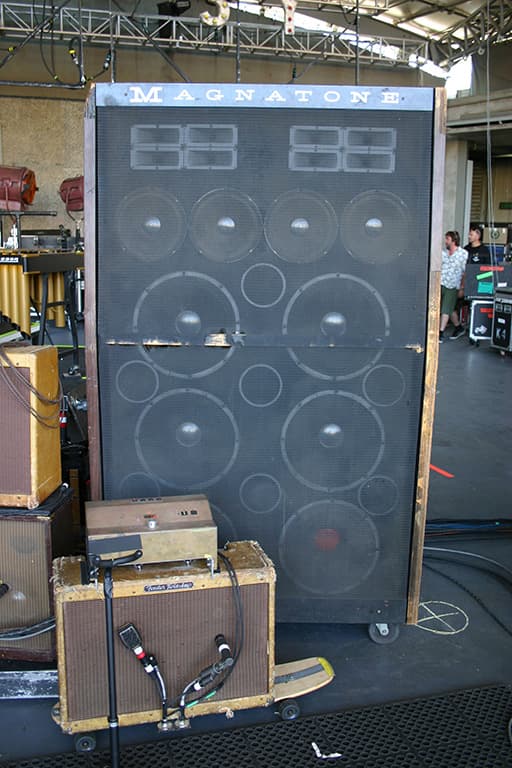


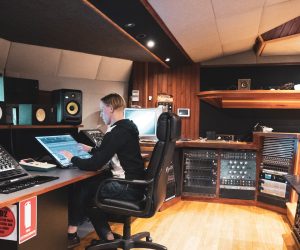


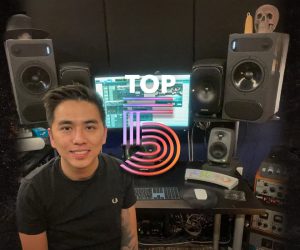



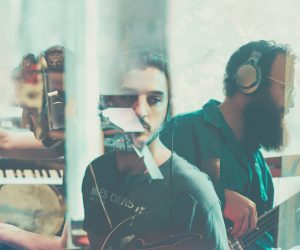






RESPONSES